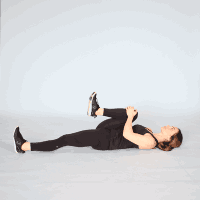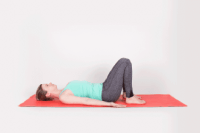Lumbar disc disease—a term that can send shivers down the spine, quite literally. If you’ve ever felt that nagging pain in your lower back, the stiffness that restricts your movement, or the discomfort that turns a simple task like tying your shoes into a painful ordeal, you might be more familiar with lumbar disc disorder than you’d like to admit.
For those battling this condition, daily life can become a series of challenges. But what exactly is lumbar disc condition? Is it a sign of aging? A result of a strenuous lifestyle? Or something more? And most importantly, what can be done about it? Let’s delve into the world of lumbar disc disease, unraveling its mysteries, symptoms, causes, and, most importantly, exploring practical solutions. So, let’s begin!
Contents
- 1 Understanding Lumbar Disc Disease: What Is It?
- 2 How to Recognize The Signs of This Disease?
- 3 Common Causes and Risk Factors of Herniated Disk Disease
- 4 Quick Home Remedies for Lumbar Disc Disease Relief
- 5 Exercises to Improve Lumbar Disc Health and Minimize Pain
- 6 When to Seek Professional Medical Help?
- 7 Conclusion
Understanding Lumbar Disc Disease: What Is It?
 Lumbar disc disease, also known as degenerative disc disease in the lumbar spine, is more common than you might think, and it’s not reserved for the elderly. It’s a condition that can affect anyone, but what exactly is it?
Lumbar disc disease, also known as degenerative disc disease in the lumbar spine, is more common than you might think, and it’s not reserved for the elderly. It’s a condition that can affect anyone, but what exactly is it?
In essence, lumbar disc disease refers to a range of issues that can occur in the discs located in the lower back or lumbar region. These intervertebral discs act as cushions between the vertebrae, allowing for flexibility and movement. Over time, these discs can degenerate, lose their cushioning ability, and cause discomfort or pain.
The reasons behind this degeneration can vary, including natural aging, wear and tear from repetitive motions, or even injuries. Factors such as obesity, genetics, or a sedentary lifestyle might contribute to the onset of this condition as well.
For some, lumbar disc disease might present with mild symptoms, while others might experience severe and debilitating pain. Understanding the nature of lumbar disc disease is essential, not only for those who suffer from it but also for those who want to take proactive measures to prevent it. Recognizing the signs and knowing the underlying causes can lead to more effective treatments and, in many cases, a healthier, pain-free life.
How to Recognize The Signs of This Disease?

Recognizing the signs of lumbar disc disease is the first step in seeking effective treatment and managing the condition. This disease can manifest in various ways, and understanding these symptoms is vital. Here’s a list of common indicators that might suggest you are affected by lumbar disc disease:
- Persistent Lower Back Pain: This is the hallmark of the condition. The pain may be nagging or sharp, particularly when bending, lifting, or sitting.
- Pain Radiating to the Hips and Legs: The discomfort may extend beyond the lower back, traveling to the hips, buttocks, or even down the legs.
- Numbness or Tingling Sensation: This can be felt in the lower back or in the areas where pain radiates.
- Stiffness in the Lower Back: A feeling of tightness or restriction in movement might be present, especially after waking up or sitting for extended periods.
- Pain That Increases with Activity: Physical activities, even simple tasks like bending over or lifting objects, can exacerbate the pain.
- Pain That Eases with Rest: Lying down or resting may bring temporary relief from the symptoms.
- Chronic Pain: The pain is not always acute; it can be a chronic, dull ache that persists over time.
- Weakness in the Legs: This symptom can be alarming and should be addressed with medical consultation as it may indicate more serious underlying issues.
- Changes in Posture: Altered stance or a hunched posture might be subconscious attempts to minimize discomfort.
It is essential to note that these symptoms can vary widely in intensity and duration. They may come and go, or they might become a persistent part of daily life.
Common Causes and Risk Factors of Herniated Disk Disease
Herniated disk disease is a common condition that can significantly impact an individual’s daily life. Understanding the triggers and underlying causes is crucial for both prevention and management. Here’s an insight into the common causes and risk factors:
Causes
- Natural Aging Process: As people age, the spinal disks lose some of their water content, making them less flexible and more prone to tearing or rupturing with even a minor strain or twist.
- Sudden Pressure or Trauma: A traumatic event like a fall or accident can cause a disk to herniate. Even lifting something heavy using your back muscles instead of your legs can lead to this condition.
- Genetics: Some individuals may be more prone to herniated disks due to inherited traits.
Risk Factors
- Weight: Excess body weight causes extra stress on the disks in your lower back, making you more susceptible.
- Occupation: Jobs that require heavy lifting, pulling, or twisting may increase the risk of herniation.
- Lifestyle Choices: Lack of exercise, smoking, and a sedentary lifestyle can contribute to poor spine health.
- Posture: Poor posture while standing or sitting can put undue pressure on the spine and disks.
- Chronic Medical Conditions: Diseases such as arthritis or chronic spinal issues can also increase the likelihood of herniated disk disease.
- Gender: Men, particularly those between the ages of 30 and 50, are more likely to suffer from this condition.
It’s vital to recognize that herniated disk disease can often be a complex condition with multiple contributing factors. While some of these causes and risks may be beyond individual control, such as genetics and age, others can be managed through mindful lifestyle choices.
Quick Home Remedies for Lumbar Disc Disease Relief
 Lumbar Disc Disease can cause discomfort and disrupt daily activities. While seeking professional medical help is essential for proper diagnosis and treatment, some immediate home remedies might provide temporary relief. Here’s what you can try:
Lumbar Disc Disease can cause discomfort and disrupt daily activities. While seeking professional medical help is essential for proper diagnosis and treatment, some immediate home remedies might provide temporary relief. Here’s what you can try:
- Cold and Heat Therapy: Applying ice packs for the first 48 hours followed by warm compresses can reduce inflammation and soothe the affected area.
- Over-the-Counter Pain Relievers: Non-prescription NSAIDs like Ibuprofen can provide short-term relief. Make sure to follow the instructions on the packaging or consult a pharmacist.
- Stretching and Gentle Exercise: Gentle stretching exercises, specifically designed for the lower back, can ease stiffness and pain. Avoid any activities that increase pain.
- Rest and Positioning: Sometimes, resting the back for a short period and avoiding strenuous activities can be beneficial. Lying down with knees bent or using a pillow between the legs while sleeping on the side can provide comfort.
- Maintain Good Posture: Being mindful of posture when sitting or standing can ease the pressure on the lumbar region. Ergonomic chairs or lumbar support cushions can be helpful.
- Stay Hydrated: Drinking plenty of fluids keeps the discs hydrated, maintaining their flexibility and resilience.
- Avoid Heavy Lifting: If you must lift something, use proper lifting techniques, engaging your legs rather than your back.
- Consider a Supportive Mattress: Sometimes, a firmer mattress can provide better support for the spine, alleviating discomfort.
- Mindful Breathing and Relaxation Techniques: Practicing deep breathing or engaging in relaxation techniques like meditation may aid in pain management.
Please note, these home remedies are not a substitute for professional medical evaluation and treatment. They may provide temporary relief but are not intended to address the underlying causes of Lumbar Disc Disease.
Exercises to Improve Lumbar Disc Health and Minimize Pain
Regular exercises, specifically designed for the lumbar region, can be crucial in managing and preventing the symptoms associated with Lumbar Disc Disease. Incorporating a gentle routine into daily life may not only alleviate discomfort but also strengthen the muscles that support the back. Here are some exercises that can help:
Pelvic Tilts

- How to do: Lie on your back with your knees bent and feet flat on the floor. Gently tilt your pelvis upward, pressing your lower back into the floor.
- Benefits: This exercise helps to engage the core muscles and promotes better lumbar alignment.
Cat-Cow Stretch

- How to do: Start on your hands and knees in a tabletop position. Arch your back towards the ceiling (like a cat) and then dip it towards the floor (like a cow).
- Benefits: This stretching exercise increases flexibility in the lumbar and thoracic spine.
Bird-Dog Exercise

- How to do: From the tabletop position, extend one arm and the opposite leg simultaneously. Hold for a few seconds and then switch sides.
- Benefits: This exercise enhances balance and strengthens both the back and abdominal muscles.
Knee-to-Chest Stretch

- How to do: Lying on your back, bring one knee to your chest and hold it with both hands. Hold for 15-30 seconds and then switch sides.
- Benefits: This stretch helps relieve stiffness and improves the range of motion in the lumbar spine.
Bridge Pose

- How to do: Lie on your back with your knees bent and your feet on the floor. Press your hips upward to form a bridge, squeezing the glutes.
- Benefits: This exercise strengthens the lower back, glutes, and hamstrings, providing better support for the spine.
Plank

- How to do: Hold your body in a straight line, supporting yourself with your forearms and toes.
- Benefits: The plank engages the entire core, promoting stability in the lumbar region.
It’s essential to approach these exercises with caution, especially if you’re currently experiencing symptoms of Lumbar Disc Disease.
When to Seek Professional Medical Help?
Lumbar Disc Disease can often be managed with home remedies and exercises, but there are specific signs that indicate the need for professional medical intervention. Recognizing these signs early can lead to more effective treatment. If you experience any of the following symptoms, it may be time to consult a healthcare provider:
- Persistent Pain: If the pain persists for several weeks despite home care and exercises.
- Severe Pain: Intensity that doesn’t lessen with over-the-counter medications or home remedies.
- Weakness, Numbness, or Tingling: Especially in the legs or feet, indicating possible nerve compression.
- Loss of Bladder or Bowel Control: This requires immediate medical attention.
- Pain that Awakens You at Night: This might be a sign of a more serious underlying issue.
- History of Cancer or Other Serious Health Conditions: As these might exacerbate or complicate the condition.
Medical Treatment Options To Manage Lumbar Disc
 If professional medical help is necessary, a variety of treatments and therapies may be available, depending on the severity and specific needs of the patient:
If professional medical help is necessary, a variety of treatments and therapies may be available, depending on the severity and specific needs of the patient:
- Physical Therapy: Tailored exercise programs to strengthen muscles and improve flexibility.
- Chiropractic Care: Adjustments to improve spinal alignment and reduce pressure on affected discs.
- Medication: Prescription pain relievers, muscle relaxants, or anti-inflammatory medications.
- Epidural Steroid Injections: To reduce inflammation in the affected area.
- Surgical Procedures: Such as lumbar decompression or discectomy, for severe cases where conservative treatments have not been effective.
- Alternative Therapies: Such as acupuncture or massage therapy, to complement other treatments.
Early intervention with the appropriate professional care can make a significant difference in the prognosis of Lumbar Disc Disease. It’s vital to communicate openly with healthcare providers about symptoms, lifestyle, and goals, to ensure the most suitable and effective treatment plan is designed specifically for your needs.
Conclusion
Living with degenerative disc disease can be a daily struggle, impacting your quality of life and ability to enjoy everyday activities. However, understanding the condition, recognizing the symptoms, and taking appropriate measures can make a tremendous difference. From home remedies to professional medical interventions, various options are available to help you manage and overcome this challenge.
If you’re experiencing Back pain, physical therapy for back pain at PhysioMantra can help: Book an online physical therapy session.



